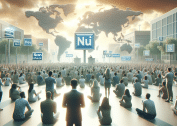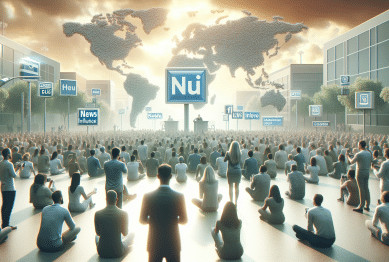Social media advertising in 2025 is being shaped by bold visual trends in social media ads that go far beyond aesthetics. From user-generated styles to AI-enhanced creative, the way we design ad visuals has changed to meet fast-scrolling, mobile-first audiences. With engagement rates closely tied to what users see first, understanding these trends is key to producing content that performs.
In addition, to stay ahead, it’s essential to understand the visual trends in social media ads that are defining performance this year. From lo-fi aesthetics to 3D design, here’s what’s shaping the creative side of paid social in 2025.

1. Native-Looking, “Unpolished” Creative
The highly-produced, polished aesthetic is making way for something that feels more authentic. In 2025, native-looking creative that mimics user-generated content (UGC) is outperforming slick, studio-quality ads.
- Why it works: It blends seamlessly into feeds, builds trust, and feels less like an ad.
- Where it’s showing up: Instagram Reels, TikTok ads, and Meta Stories.
According to HubSpot’s 2024 State of Marketing Report, 56% of marketers say UGC-style ads now outperform traditional formats across multiple platforms.
2. Motion-First Design
Static images are losing ground to motion-led formats. From subtle animated overlays to full-on kinetic typography, motion-first design is dominating the ad space.
- Short animations and loops keep users watching longer.
- Kinetic type and GIF-style movement make key messages stick.
With TikTok, Reels, and Shorts continuing to grow, ad creatives that include movement—no matter how minimal—see up to 3x more engagement than still images, according to Social Media Examiner.
3. Bold, Maximalist Color Palettes
Minimalism is taking a backseat in favor of vivid, expressive color. In 2025, social ads are leveraging bold contrasts and maximalist palettes to grab attention fast.
- Think neon gradients, digital saturation, and layered textures.
- High-contrast schemes improve readability on mobile screens.
This trend is especially effective on TikTok and YouTube Shorts, where full-screen vertical content needs to hold attention immediately. Brands like Duolingo and Fenty Beauty are using color as a personality amplifier, not just a design feature.
4. Vertical-First, Full-Screen Formats
It’s official: vertical video is the default. From Meta to YouTube, platforms are prioritizing vertical content for organic and paid distribution.
- 9:16 aspect ratio is now the standard for mobile-first ads.
- Square and horizontal assets are underperforming in feed placements.
Even B2B brands are adapting, with LinkedIn Stories-style ads and vertical case studies gaining traction. The shift reflects how people consume media—upright, full-screen, and thumb-controlled.
5. Data-Layered Creative (Visualized Metrics)
Infographics are being replaced by data-layered video—think charts, ratings, and social proof baked right into the creative.
- Products showing “4.8-star average from 1,200 reviews” directly in the frame.
- Dynamic overlays like countdown timers or progress bars encourage clicks.
This trend meets the need for quick credibility in ad formats where attention is limited. Platforms like Facebook and TikTok are now offering templates that allow you to integrate visual stats directly into the creative.
6. AI-Enhanced Visuals
AI tools are reshaping how creatives are built and tested. While not always visible to the viewer, AI-enhanced visuals are driving ad performance behind the scenes. AI-generated images are no longer a novelty; in fact, brands are using them to create dynamic ad visuals at scale.
- Brands are using tools like Runway, Canva’s AI features, and Adobe Firefly to generate variations and test creative elements.
- AI helps predict which thumbnails, colors, and layouts will perform best before launch.
Marketers are reporting reduced production time and more creative agility—important in a space where ads need to evolve weekly, not quarterly.
For more on this trend, see Canva’s 2025 Visual Trends Report.
7. Personalized Visual Targeting
Visuals are becoming more personalized based on audience data. In 2025, we’re seeing more brands use:
- Demographic-based color and style shifts
- Geo-targeted backgrounds and models
- Time-sensitive creative that changes visuals depending on time of day
This is made possible through Dynamic Creative Optimization (DCO) and platform integrations with CRMs and CDPs. It results in visuals that feel tailored—not just templated. Clean, minimal fonts are trending again. As a result, this helps content stand out in crowded feeds.
8. Text-Heavy but Mobile-Friendly
Furthermore, in contrast to years past, more text is showing up in ads—but it’s highly intentional and mobile-optimized.
- Short, bold headlines placed front and center.
- Supporting text is layered in graphic styles, often animated.
- Captions and subtitles are baked into video, not added as an afterthought.
The trend stems from accessibility concerns and the rise in muted playback. Meta reports that over 80% of users watch videos with sound off, and then make text essential too.
Final Thoughts: Creativity That Converts in 2025
Finally, the visual trends in social media ads this year are shaped by changing user habits, platform features, and creative tech. But underneath it all is one core shift: visuals must now communicate meaning instantly, often without sound or context.
Marketers need to think beyond aesthetics. Every pixel, motion, and layout choice needs to serve the message, engage the viewer, and feel relevant to the feed it appears in.
If your ad creative isn’t evolving alongside the platform, chances are your audience is scrolling past.
References:
- HubSpot – State of Marketing Report 2024
- Social Media Examiner – Video Content Trends
- Canva – Visual Trends 2025









